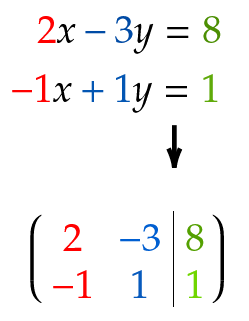Hier werden die Zusammenhänge von Linearkombinationen, (linearen) Gleichungssysteme und Matrizen gezeigt.
Das Ziel ist es, zu verstehen, wieso ein lineares Gleichungssystem (siehe Bild) geschrieben werden kann als Matrix.

Ein Beispiel für ein lineares Gleichungssystem. Das kann auch mit einer Matrix geschrieben werden.
Wenn hier den Begriff Gleichungssystem oder auch einfach nur System verwendet wird, ist immer ein lineares Gleichungssystem gemeint.
Linearkombinationen und Gleichungssysteme
Wir beginnen mit einem Gleichungssystem:
welche beiden Zahlen und erfüllen beide Zeilen gleichzeitig?
Das kannst du mit einem der bekannten Verfahren wie Additionsverfahren oder Gaußverfahren berechnen. Die Lösung ist übrigens und .
Als nächstes schreiben wir das Systems in Vektoren um und wenden die Rechenregeln an:
Welche Koeffizienten und braucht man, um den Vektor als Linearkombination von und darzustellen?
Das Gleichungssystem und das Problem
"Welche Koeffizienten , und braucht man, damit die Linearkombination
den Vektor ergibt?"
haben die selben Lösungen. Es sind verschiedene Schreibweisen desselben Sachverhalts.
Linearkombinationen und Matrizen
Sicher hast du schon gesehen, wie man eine Matrix mit einem Vektor multipliziert:
Ist und , dann ist .
Das ist vollkommen richtig und hilfreich beim konkreten Berechnen, aber für das Verstehen formt man das noch mal um:
Unser Beispiel lässt sich deshalb so umformen:
Daher stellst du fest:
Ist eine Matrix und ein Vektor, so ist das Produkt eine Linearkombination der Spalten von mit den Koeffizienten der Einträge von
Dabei siehst du noch einmal zwei Dinge:
Es ist sinnvoll, die Matrix nicht nur als rechteckiges Schema zu betrachten, sondern als Anreihung von (Spalten-)Vektoren.
Ein Produkt kannst du genau dann bilden, wenn die Spaltenzahl von gleich der Zahl der Einträge in ist.
Die Frage: welche Linearkombination der Vektoren und ergibt den Vektor , also:
Wie muss ich und in der Gleichung wählen?
kann auch so formuliert werden:
Welcher Vektor löst die Matrix-Vektor-Gleichung ,? Dabei ist eine Matrix mit den Spalten und .
Gleichungssysteme und Matrizen
Jetzt kannst du die Abschnitte über Gleichungssysteme, Linearkombinationen und Matrizen einfach zusammenfassen:
Das Gleichungssystem ganz am Anfang
schreibt sich jetzt als erweiterte Matrix
und der Vektor ist die Lösung der Gleichung
Das Gleichungssystem
ist äquivalent zu diesem Problem mit den Matrizen:
Ist und , so ist der Vektor die Lösung von
In Worten: Mit welchem Vektor muss man multiplizieren, um zu erhalten?
Umgekehrt kann die Lösung von durch das Lösen des Gleichungssystems bestimmt werden.
Das führt zu folgender Schreibweise
Das Gleichungssystem in der Box oben schreibst du in der Form
